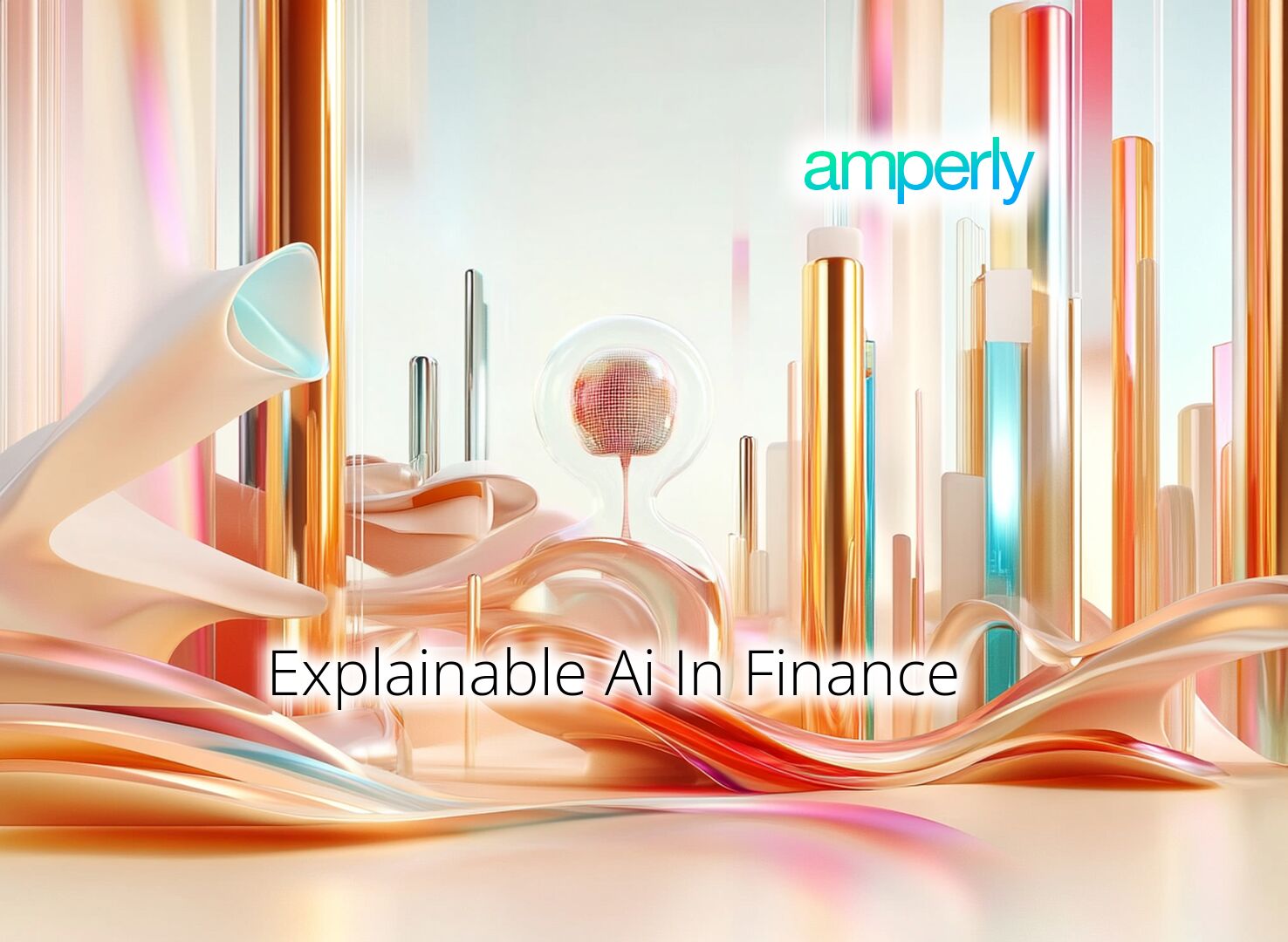Explainable AI in finance isn’t just a technical buzzword—it’s the key to making smarter, fairer decisions in banking. Whether it’s clarifying why a customer’s loan was denied or explaining how fraud was detected, you need AI systems that don’t leave questions unanswered. If you’ve ever faced skepticism from customers or compliance teams, this post will show you how explainable AI can make your work smoother and build trust.

You can dive deeper into how AI enhances fraud detection in banking by checking out artificial intelligence in fraud detection. You can learn more about how KRR aids with AI here knowledge representation and reasoning.
Explainable AI Applications in Financial Decision-Making
Explainable AI in Financial Decision-Making: It’s clear explainable AI in finance isn’t just a buzzword—it addresses a real issue with “black box” models eroding customer trust. The 2022 LendIt survey showed that a lack of AI transparency and explainability was the second-highest concern for 32% of financial executives. By using explainable AI applications, such as white-box credit models, you can provide clear reasons for loan approvals or rejections to both customers and regulators, ensuring trust and compliance.
Improving Transaction Transparency with Explainable AI: False declines and vague explanations during card transactions frustrate your customers and hurt loyalty. One example highlights how insufficient funds, though often incorrectly flagged, worsens customer trust issues at critical moments, like emergencies. Implement explainable AI tools that provide clear, case-specific reasons for declines to significantly reduce these negative experiences and improve customer retention in explainable AI finance systems.
Improving Customer Trust through Explainable AI in Banking
Improving Customer Trust with Explainable AI in Finance: When a late-night credit card transaction is declined, customers deserve answers. Yet, research shows the second-highest concern for financial executives is the lack of AI transparency and explainability, as cited by 32% in a 2022 survey. By using explainable AI in finance, like assigning clear reason codes, you can provide straightforward explanations, helping rebuild trust with frustrated customers.
Enhancing Compliance through Explainable AI Applications: With increasing global regulations, banks must ensure AI models meet standards like the ECOA or EU’s upcoming Intelligence Act. Explainable AI applications address these demands by creating global and local explainability for models, helping analyze why a loan was denied or identifying bias. By meeting compliance needs transparently, you not only avoid penalties but also improve customer interactions.
UKU.ai with explainable KRR
Uku.ai addresses a core issue in AI-driven banking systems: ensuring accurate and reliable decision-making without the risk of false outputs. Current systems can generate misleading information, causing issues in areas like credit risk analysis, loan approvals, and fraud detection. Uku’s approach combines statistical estimation with logical reasoning, providing clear, verifiable decisions backed by real-time updates. This removes the risks associated with traditional “black box” AI models, ensuring transparency and accountability in banking processes.
With increasing regulatory demands, such as the EU AI Act imposing significant penalties for non-compliance, Uku’s solution allows banks to maintain trust and meet legal standards. Its implementation offers a robust way to improve AI reliability in critical banking operations.
Contact us today to see how to redefine accuracy and reliability for your organization.
AI Data Privacy and Security Risks in Finance
Lack of AI transparency and explainability in finance: The unchecked “black box” models in finance erode trust and leave customers without understanding why decisions, like transaction declines, occur. In a 2022 survey, 32% of financial executives cited this lack of explainability as their second-highest concern, just after regulation and compliance. Explainable AI in finance not only improves customer relationships but also ensures transparent decision-making processes, keeping both clients and regulators satisfied.
Explainable AI applications for regulatory compliance: As AI adoption surges, aligning systems with regulations like the Equal Credit Opportunity Act in the U.S. or the EU’s AI Act is non-negotiable. Global explainability helps validate model fairness across many predictions, while local explainability pinpoints reasons for specific decisions, like why a loan application was denied. Using explainable AI in finance safeguards institutions, minimizes non-compliance risks, and meets customer expectations for fairness.
Addressing AI Model Bias for Regulatory Compliance
Improving Trust Through Transparency with Explainable AI in Finance: You deal with customer frustrations regularly, like explaining why a loan or transaction was denied. The lack of explainability was cited as the second-highest concern by 32% of financial executives in LendIt’s 2022 survey. Adopting explainable AI applications ensures the interactions between data points are transparent and give you clear reasons behind every outcome.
Reducing Bias for Regulatory Compliance Using Explainable AI in Finance: Models trained on historical data can unintentionally propagate biases, which might violate laws like ECOA or GDPR. Explainable AI makes it easier to detect and remove these biases, aligning AI systems with legal frameworks, which is crucial for financial institutions operating across regions. Building systems with “reason codes” allows you to conduct fairness audits and adjust outcomes proactively to meet global regulatory demands.
Balancing Accuracy and Explainability in Financial AI Systems
Balancing accuracy with transparency in explainable AI in finance: Banks often face the challenge of deploying AI systems that are both accurate and understandable to stakeholders. According to the 2022 LendIt annual survey, 32% of financial executives cited lack of AI transparency and explainability as their second-highest concern, just after regulatory compliance. By adopting explainable AI applications, you can build trust and ensure customers grasp why decisions, like loan approvals or fraud alerts, are made. Start assessing today whether your AI systems strike the right balance between performance and clarity.
Explainable AI addresses regulatory and bias concerns: Compliance with diverse regulations and tackling biased outputs is now mandatory for financial institutions operating across regions. Explainable AI in finance can help audit fairness in predictions, ensuring sensitive data like gender or zip codes are excluded, thus meeting requirements like the EU’s upcoming Intelligence Act. Beyond compliance, transparent models foster trust among customers who demand clarity on decisions that impact their finances. Share this insight with your risk team—how confident are you that your current models meet these standards?
Use of Explainable AI in Risk Management
The importance of explainable AI in risk management: Banks face rising pressure to explain decisions in credit risk and fraud detection. In a 2022 survey, 32% of financial executives cited lack of AI transparency as their second-biggest concern, after regulation and compliance. With explainable AI in finance, you can show clear reason codes for outputs, making it easier to justify actions both internally and to customers, which helps maintain trust and meet regulatory demands. Ask yourself—how much time and confidence could your team save with clearer, automated justifications?
Explainable AI simplifies fraud prevention and compliance: Fraud detection systems must process enormous volumes of data rapidly and often rely on black-box machine learning models. However, explainable AI applications ensure maintaining clear audit trails while explaining the intricate decision-making process behind flagged transactions. By integrating explainable AI in finance, your organization can meet legal requirements while helping customers understand why actions, like transaction declines, occur. Are your current systems transparent enough to support both compliance and customer trust?
Local and Global Explainability for Predictive Financial Models
Transparency to Build Trust with Customers: Explainable AI in finance can provide clear reasoning for decisions like loan rejections or credit declines. Research shows that 32% of financial executives rank the lack of AI transparency as a top concern after compliance (2022 LendIt survey). By providing easy-to-understand explanations, you can enhance customer trust and minimize frustration during sensitive interactions. Ask yourself: How would greater transparency impact your team’s customer satisfaction scores?
Local and Global Explainability for Better Decisions: Implementing local and global explainability gives granular insight into AI decisions for specific cases and broader patterns. For instance, local explainability helps pinpoint why an individual loan was denied, while global insights identify key factors influencing all predictions, improving your system’s reliability. By adopting these explainable AI applications, you tackle compliance needs and foster informed decisions. Could making outcomes more transparent streamline your team’s day-to-day operations?
Visual Explanation and Accessible Insights for Stakeholders
Explainable AI mitigates the lack of AI transparency in finance by clarifying outputs and decision-making. Financial executives noted explainability as the second-highest concern, with 32% prioritizing it after regulation and compliance in the 2022 LendIt survey. By using explainable AI in finance, banks gain the ability to provide clear justifications for actions like credit denials, reducing customer complaints and potential churn. Focus on using frameworks like SHAP or LIME to improve the clarity and accuracy of your institution’s AI systems.
Explainable AI applications in risk management improve compliance while building customer trust. AI models must meet laws like the U.S. Equal Credit Opportunity Act (ECOA), which ensures fairness in processes like loan approvals. Methods like global explainability identify the top influences on predictions across all transactions, helping banks reduce biases and avoid penalties. Apply these techniques in credit scoring or fraud detection to ensure data-driven decisions meet both compliance requirements and customer expectations.
Governance Frameworks for Ethical and Transparent AI Usage
The importance of explainable AI in finance for transparency and compliance: When banks rely on black box models, it’s hard to explain to customers why decisions were made, like declining a credit card purchase in an emergency. Lack of AI transparency was identified as the second-highest concern for 32% of financial executives in the 2022 LendIt survey. Explainable AI in finance addresses this by making outcomes traceable and understandable, which can restore trust and improve customer satisfaction.
Governance frameworks to support explainable AI applications: Banks managing explainable AI tools must follow clear governance to ensure AI systems operate fairly and responsibly while staying compliant. Mastercard’s ‘Five Pillars of AI’ framework demonstrates how ethical AI practices can minimize bias and make AI more transparent. You can adopt similar models, ensuring your AI systems maintain accountability and provide clarity to both developers and end-users.
Real-World Challenges Solved by Explainable AI in Banking
Explainable AI improves customer trust in banking decisions: Explainable AI in finance makes it easier for you to reduce the frustration your customers feel by offering clear, understandable reasons for decisions like why a loan was rejected or a transaction declined. For example, the lack of transparency in AI decisions is the second-highest concern for 32% of financial executives, according to the 2022 LendIt survey. By deploying explainable AI, you can give customers a better experience while also meeting regulatory compliance.
Explainable AI addresses regulatory demands while preventing bias: Financial institutions like yours are increasingly required to meet stricter explainability and fairness standards for AI systems, such as compliance with the EU AI Act or U.S. credit laws like ECOA. For example, techniques like SHAP and decision trees not only provide transparency but also help prevent the use of sensitive variables like race or gender from influencing decisions. When you adopt explainable AI in finance, it’s not just about meeting legal requirements—it’s about ensuring your systems are unbiased, trustworthy, and transparent.
Artificial Intelligence Services
Artificial intelligence is transforming finance, but it’s not just about speed and accuracy. Explainable AI is critical to making finance more transparent, fair, and customer-friendly. Here are the three most important AI services we provide to help financial institutions achieve this.
Dynamic Product Descriptions Using AI Personas
AI personas are powerful tools for creating more relatable customer experiences. By bridging explainable AI with marketing, our dynamic product descriptions align perfectly with what financial customers need. These descriptions boost engagement while ensuring transparency in how AI tailors them based on consumer preferences.
AI Email Replies and Lead Nurturing Flow
Clear, timely communication builds trust—especially in finance. Our AI email replies and lead nurturing flow ensures every reply is precise, prompt, and explainable. Transparent processes make every customer interaction feel meaningful, helping you maintain compliance and customer loyalty.
Artificial Intelligence Consulting Services
Navigating explainable AI adoption in finance isn’t easy, but we’ve got you covered. Our AI consulting services help you integrate models that ensure outcomes are easy to understand for both regulators and customers. From white-box models to fairness audits, transparency is built into every strategy.
These tools make AI more than just powerful—they make it human. Ready to see how explainable AI can improve your financial services? Learn more about our AI services. You can learn more about how AI aids in credit scoring transparency by checking out AI in financial services.
Unlocking Transparency: How to Adopt Explainable AI in Finance
1. Start by assessing if your current AI systems offer enough transparency to customers and regulators. Identify gaps where explainable AI can provide clearer insights for decisions, like credit approvals or fraud detection.
2. Collaborate with your compliance team to implement explainable AI tools that meet standards like the ECOA or EU AI Act. Focus on methods like local and global explainability to ensure fairness and transparency.
If you’re looking for guidance on adopting explainable AI in finance, contact us for tailored advice. Let’s help make your AI systems more transparent and compliant.

